
The Neutrino Legend and the Collapse of Particle Physics
By Mathias Huefner
Three big questions have preoccupied academic mainstream astrophysicists and particle physicists for decades:
- Why does a super-giant star suddenly explode in a blinding glare brighter than 100 billion stars after shining steadily for millions of years?
- Which exotic objects in space fire particles with easily the highest energy in the universe?
- Why does the universe contain matter at all?
It is an idea that neutrinos could hold the key to unlocking the solutions to three central mysteries in astrophysics. Mainstream astrophysicists believe the universe is awash with these strange, nearly massless, subatomic particles. Trillions of these ghostly particles, which are said to have arisen in enormous numbers immediately after the Big Bang and are constantly being released in stars and other places through radioactive decay and other reactions, are said to permeate stars and planets, including our own because they have virtually no interaction with charged elementary particles. The collision rate of these chargeless and mass-less ghost particles is approximately 1 in 2 trillion since they do not interact with electromagnetic fields. Nevertheless, neutrinos are considered to play a crucial role both in the functioning of the universe and in unveiling some of its greatest mysteries. Neutrinos are at the center of the cosmic legends that astrophysicists have been spinning for decades and are constantly presenting new wonders to the public, which are eagerly received and honored with Nobel Prizes, even though these legends do not benefit humanity.
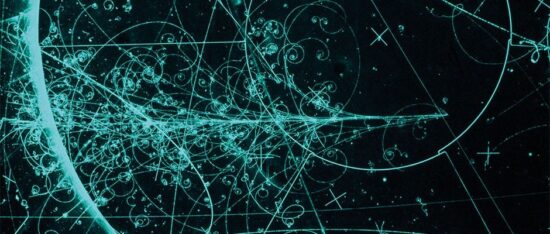
To the facts
At the beginning of the 20th century, electricity was so developed that its smallest building blocks, the electron and the proton, had been identified. After Lord Kelvin identified the negative charge of an electron, he proposed a model of the atom consisting of positive and negative charges arranged in a spherical manner. Then Ernest Rutherford in 1911 using scattering experiments of alpha rays on a gold foil showed that an atom must consist of a negative shell and a positive nucleus. Not only is the atom considered spherical, but its charge-carrying components are also thought of as spherical.
Walter Ritz, a student of Antoon Lorentz, guessed that the elementary particles have an angular momentum as Maxwell’s equations said. He suspected elementary magnets. Analogous to Lorentz, a rotating point charge creates a magnetic moment. In 1911, the unknown Romanian physicist Ștefan Procopiu, a student of Niels Bohr, was the first to find the exact value of the magnetic moment for an electron1 by using Planck’s constant for the electron for calculation. This moment later became known as Bohr’s magneton. The connection between ferromagnetism and the angular momentum of electrons was demonstrated in 1915 by Albert Einstein and Wander Johannes de Haas.2 Unfortunately, there was a difference of ½ between the calculations of Procopiu and Einstein-de-Haas experiment, as a result of which Procopiu’s calculation was based on an entire revolution and the experiment was oriented of half a revolution. After taking multiple measurements, it was confirmed that the information provided by Procopiu was accurate and consistent. However, it had no corrective influence on the further development of particle physics.3, 4
Eight years later, Rutherford was able to do so in 1919. He identified the hydrogen atom’s nucleus as the smallest amount of positive charge. As early as 1815, the Briton William Prout believed that all atoms would consist of hydrogen atoms, based on a simplified interpretation of early values of atomic weights. In honor of Proud, he named the hydrogen nucleus proton (the first). Rutherford found the electrons in the atom shell to have a very low density. However, the atom shell is wider than the dense positive nucleus, but Rutherford could not explain why the electrons do not fall into the nucleus and how discrete spectral lines come about.
Indeed, no one could explain why the moon doesn’t fall to Earth. Albert Einstein tried the “curvature” of space as an explanation, but only surfaces are curved. A crisis in physics and mathematics led to a belief in miracles.
At the beginning of the 20th century, physicists faced the intellectual problem of the transition from the continuous to the discrete approach. It was not possible in the usual mechanical thought structures. The question of scaling did not yet play a role in physics. That led to a break with electrodynamics.
The emergence of quantum mechanics was the first attempt to overcome this intellectual crisis, but it led to the abandonment of causality. In 1930, Wolfgang Pauli observed electron emission from atoms and, influenced by the ideas of quantum mechanics, was amazed by their continuous energy spectrum. This appeared to be a problem. Due to the erroneous assumption that there was a factor of ½ between mechanical and magnetic torque, the opinion had now become established that every elementary particle has a “nuclear spin” of what is called “1/2 unit”.
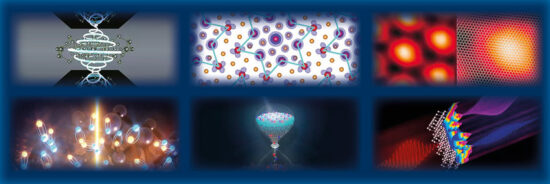
The quantum mechanics should have been surprised by this. A torque is a vector quantity. That has multiple orientations in space rather than a simple number. So, nobody could conclusively explain the spin. However, it was adopted as a prerequisite by Paul Dirac in his equation, which, in contrast to Schrodinger’s wave function, accounts for the requirements of the Special theory of relativity. In 1926, when Einstein tried to understand a paper by the then 24-year-old British physicist, who was unknown to him, he wrote almost desperately in a letter:
I have problems with Dirac. This balancing act on the dizzying path between genius and madness is terrible.
Pauli, however, suspected that there was a neutral particle in the atomic nucleus, which he called a neutron. If three particles were involved in beta decay, the electron could absorb any momentum from zero to the maximum allowable value, with the other light “invisible” particle balancing it out. The idea was not initially well received.
When James Chadwick succeeded in experimentally proving the existence of a new lead-permeable particle in 1932 by bombarding beryllium atoms with alpha rays from polonium, the discovered particle was named neutron. It proved unstable and decayed into a proton and an electron with a half-life of 14.6 minutes. Now, the electron should have a spin of ½. But this seemed to violate the momentum law.
In 1933, Enrico Fermi developed a Theory of beta decay that involved a virtual particle, which he assumed was both massless and chargeless and should only have spin ½. He named it Little Neutron (Italian neutrino).
Neutron → proton + electron + (anti-)neutrino
He then explained that nuclear spin is conserved:
1/2 → 1/2 + 1/2 + -1/2
The type of interaction that led to beta decay was later called a weak interaction, and the associated forces were named weak nuclear forces. This was in contrast to the strong nuclear forces that were supposed to hold the many protons together in the presence of approximately the same number of neutrons in the nucleus.
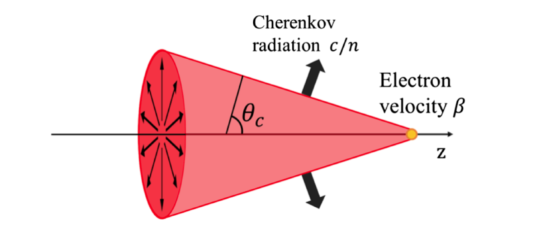
In 1953, Clyde Cowan and Fred Reines first set out to observe neutrino interactions. They set up two tanks with diluted cadmium chloride (CdCl2 ) in water, which were embedded between three tanks equipped with liquid scintillators while shielded from cosmic radiation by thick earth walls. Using this method, they observed flashes of Čherenkov radiation. The Čherenkov radiation occurs due to the rapid movement of charged particles (e.g. electrons, i.e. beta radiation) in a medium that is not electrically conductive or only slightly conductive. While working at the Institute for Radioactivity in Leipzig, I measured beta radiation using scintillation detectors.
It is a known fact that a neutrino has no electric charge.
But ONLY CHARGED PARTICLES can produce Čherenkov radiation.
This logically excludes the detection of neutrinos. Earth’s rocks have natural radioactivity. Beta decay can be observed everywhere, even in the deepest mine tunnels. In 1995, Reines received the Nobel Prize for his questionable neutrino detection (Cowan had died by then.) Neutrinos must now be used for all inexplicable phenomena in space, whether the Sun, black holes, or other dark mysteries.
The erroneous gap between the magnetic and mechanical torque of the atom and electron, called spin, was not only the reason for the invention of the neutrino but also for the invention of a whole particle zoo of virtual elementary particles, which were classified according to the size of this gap. However, none of these “particles” could have a lifetime of more than microseconds. The main result of the particle accelerator at CERN was that there were only two stable elementary particles. This is the proton with a positive charge and the electron with a negative charge.
The Standard Model of elementary particles is just as much of a mirage as the Standard Model of cosmology. It is intended to describe the situation at the moment of the Big Bang. The logical problem with both models is that in the state of an explosion, the entropy change reaches a maximum, which contradicts both an act of creation and evolution. Both require a negative entropy change. According to the second law of thermodynamics, a negative entropy isn’t possible in an expanding closed system. The negative entropy change requires an open system that allows the waste to be removed.
Conclusions
Contrary to the physicists of the 19th century, who wanted to trace all movement back to mechanics, we now know that there is only one force measured in Newton, and that applies to all physical movements, regardless of whether they are electrodynamics, thermodynamics, or mechanics. As masses are carriers of electrical charges, we must return to Maxwell’s considerations on electrodynamics. However, we now look at the system of equations from the perspective of an open system that has an input with a force source, represents a transmission channel, and has an output where a denser phase unrolls the energy as a result of negative acceleration (Figure 1).
Maxwell’s idea is based on the vortex movement of electrical charges and the magnetic vortices perpendicular to them. If the vortex axes are closed to a ring, the masses move without force, which is why neither the electron nor the moon crash. Hermann v. Helmholtz studied liquids and realized that vortex axe-ends are always closed to a ring if they do not encounter a phase boundary. If a denser phase is encountered, as Max Planck recognized, it exerts an energetic effect on the boundary layer. Heinrich Hertz recognized that if you open the boundary to a less dense medium, the vibration impulses spread further into the thinner medium like a tsunami. Most physicists seem to have a problem thinking about mechanics and electrodynamics in one way.
Our goal here is to create a basic atom model using Maxwell’s and Helmholtz’s vortex ideas. Edo Kaal developed a Structured Atom Model on electrostatic forces, which he presented for the first time at the EU 2017 in Phoenix. I have been thinking about his idea for several years. Still, I prefer the internal magnetic forces within the atomic nucleus that can be traced back to the magnetic moments of elementary particles. These forces have been proven, although not as quantum mechanical spin. Furthermore, I see myself in the historical tradition of electrodynamics.
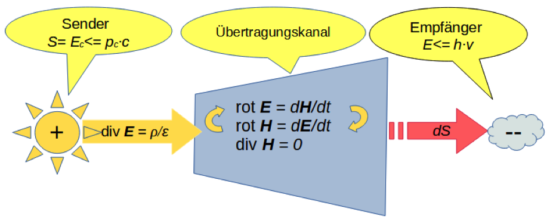
The first attempts at a vortex model of the atom go back to William Thomson, later Lord Kelvin. However, he had to fail with his mechanical model without the effect of electromagnetic forces.
I can never be satisfied until I can make a mechanical model of something. If I can create a mechanical model, I can understand it. Unless I can fully create a mechanical model, I can’t understand it.
— Lord Kelvin
Maxwell’s system of equations must apply universally across the entire electromagnetic spectrum. Nevertheless, there are different explanations for the creation of electromagnetic waves. One thing is obvious to physicists, the first possibility is the “energy jumps” of an atom, and the second possibility is the alternative braking processes of atoms, molecules, or charged particles. If electrical charges oscillate in an antenna, they create electromagnetic waves, according to communications engineers. (Figure 2) Why should electromagnetic waves be generated in different modes, and where is the transition between the modes? It’s just a question of scaling. As a result, I have sketched a distinct atomic model that resolves this discrepancy. While there has been a success with Bohr’s shell model for the electron shell, no previous model of the atomic nucleus has been able to provide a satisfactory explanation for the three types of rays – α, β, and γ.

On the shape of elementary particles
By an elementary particle, I mean a stable unit, whose lifespan is not limited, which is a comparable mass and an electrical charge. Despite all attempts at fission, an elementary particle returns to its original shape within microseconds. The negative electron and the positive proton, which is 1836 times heavier, meet this criterion only. That means our world is bipolar.
If you observe images of elementary particles from mainstream particle physics, you will notice that they are always represented as spherical objects. String theory deviated only from this idea but got lost in multidimensional spaces without any physical statement: “I cannot agree with a spherical shape.”
How then can electrons combine to form currents? Because they have the same polarity of charge, they would have to fly apart in all directions.
Let’s have a look at a rotating load. The mass of a rotating sphere is pushed outward by centrifugal force, but a magnetic moment of a moving charge acts perpendicular to it. This moment increases with the rotation speed and constricts the mass around the rotation axis. As the rotation speed increases, the ellipsoid of rotation develops into a vortex ring, a Toroid. From the superposition of two mutually perpendicular force fields, elementary charges are likely to move helically in the volume of a ring torus, as shown in Figure 3. If you look at the image from above, you can see the de Broglie wave. You can also think of the Schrodinger wave function. However, oscillation in one plane requires a reversal of direction, which always requires additional effort. A screw motion, in contrast, is force-free because the speed remains constant, as the moon’s orbit teaches us, which revolves around the vortex thread of the Earth’s orbit.
Consequently, elementary particles must have a toroidal structure. As long as the charge circulates in the Toroid, it will not release or absorb energy. If the Toroid is interrupted at one point, an open oscillating circuit unfolds because the charge can no longer rotate without force. In a Toroid, rotating H-field forces the charge to screw motion around the vertex axis, creating an inductance. The open ends of the vortex axis form the capacitance of a dipole, and a flash of light of a constant wavelength will emitted. This would provide a clear answer to the second question, which Rutherford could not answer.
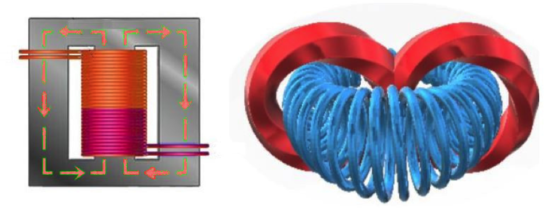
If the neutron has no stable existence outside the atomic nucleus, why should it exist within the atomic nucleus as an independent particle? As the neutron consists of a proton connected to an electron, it is conceivable that the electron also penetrates the neighboring proton and forms an elementary magnet as a core electron (Figure 3). This creates the fundamental building block for all stable atoms, which have an equal number of protons and neutrons. An exception is beryllium 8, which immediately decays into two alpha particles. It turns out that a tetrahedron made of four elementary magnets is not stable. I reported in detail about the nuclear structure in my book Dynamic Structures in an Open Cosmos5. The core electron passes through the two protons like the coil windings of a transformer. As a result of the atomic nucleus being three orders of magnitude smaller, a gamma quantum emits when a core electron vortex opens.
This would not only close the gap between mechanical and magnetic moment and make the ominous spin unnecessary. This means that the neutrino no longer has any right to exist, and the secrets of the cosmos that the electromagnetic radiation conveys to us are the same that earthly sources emit without any divine transcendence. We simply need to go and read their information instead of making mathematical speculations unsupported by reality.
[1] Ștefan Procopiu – Determining the Molecular Magnetic Moment by M. Planck’s Quantum Theory. In: Bulletin scientifique de l’Académie roumaine de sciences . Volume 1, 1913, p. 151.
[2] A. Einstein, WJ de Haas – Experimental proof of Ampere molecular currents, German Physical Society, Negotiations 17, pp. 152–170 (1915) https://archive.org/stream/handlungen00goog#page/n167/mode/2up
[3] Emil Beck – On the experimental proof of Ampere molecular currents – In Annals of Physics Vol. 60, 1919, pp. 109–148
[4] Peter Galison – Theoretical predisposition in experimental physics: Einstein and the gyromagnetic experiments 1915 – 1925. In Historical Studies in the Physical Sciences. Vol. 12, No. 2, 1982, pp. 285-323
[5] M. Hüfner – Dynamic Structures in an Open Cosmos; Books on Demand 2021; ISBN-13: 9783755713753 https://buchshop.bod.de/dynamic-structures-in-an-open-cosmos-mathias-huefner-9783755713753 https://www.amazon.com/Dynamic-Structures-Open-Cosmos-Stigmergy/dp/3755713756

Dr. Mathias Hüfner is a German translator volunteer for The Thunderbolts Project. He studied physics from 1964 until 1970 in Leipzig Germany, specializing in analytical measurement technology for radioactive isotopes. He then worked at Carl Zeiss Jena until 1978 on the development of laser microscope spectral analysis. There he was responsible for software development for the evaluation of the spectral data. Later he did his doctorate at the Friedrich Schiller University in the field of engineering and worked there 15 years as a scientific assistant. Some years after the change in East Germany, he worked as a freelance computer science teacher the last few years before his retirement.

Since 2015, Mathias has run a German website of The Thunderbolts Project http://mugglebibliothek.de/EU and his latest book is entitled Dynamic Structures in an Open Cosmos
The ideas expressed in Thunderblogs do not necessarily express the views of T-Bolts Group Inc. or The Thunderbolts Project.












